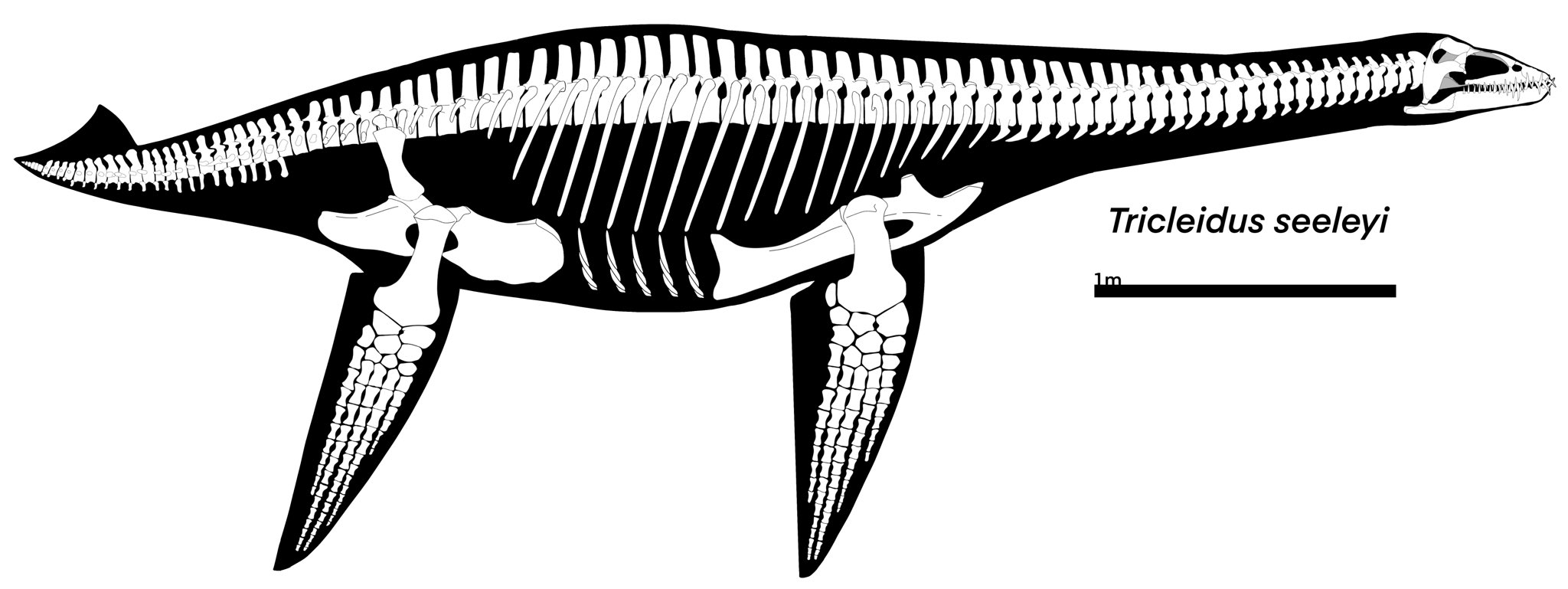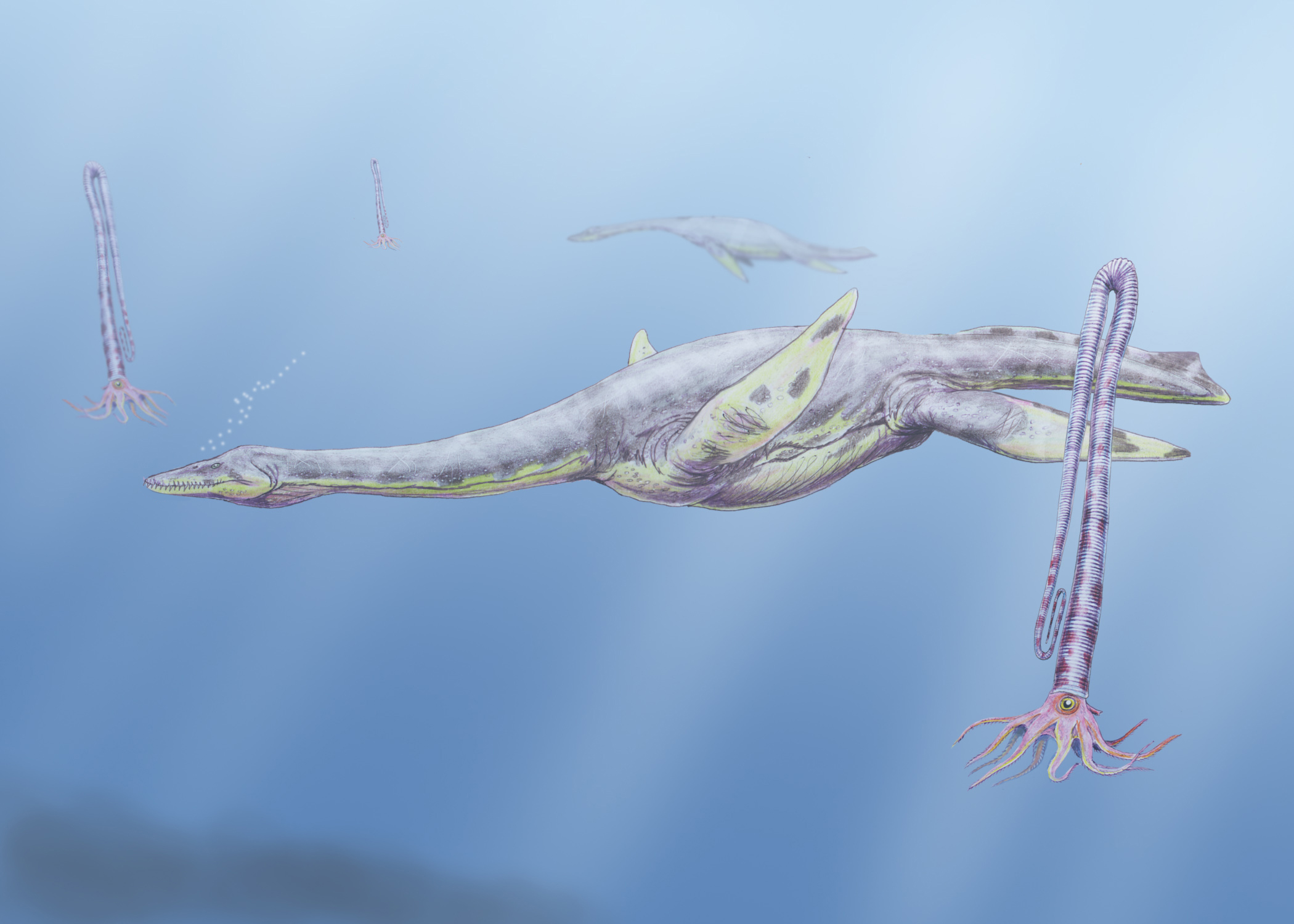|
Tricleidus Seeleyi
''Tricleidus'' is an extinct genus of cryptoclidid plesiosaur known from only specimen (BMNH R3539) from the middle Jurassic of United Kingdom. It was first named by Andrews in 1909 and the type species is ''Tricleidus seeleyi''. One species, ''T. svalbardensis'', was moved into '' Colymbosaurus'' in 2012. It was found in the Agardhfjellet Formation, Norway. See also * List of plesiosaur genera * Timeline of plesiosaur research This timeline of plesiosaur research is a chronologically ordered list of important fossil discoveries, controversies of interpretation, Taxonomy (biology), taxonomic revisions, and cultural portrayals of plesiosaurs, an order of marine reptiles ... References Cryptoclididae Middle Jurassic plesiosaurs of Europe Fossil taxa described in 1909 Taxa named by Charles William Andrews Oxford Clay Sauropterygian genera {{plesiosaur-stub ... [...More Info...] [...Related Items...] OR: [Wikipedia] [Google] [Baidu] |
Middle Jurassic
The Middle Jurassic is the second Epoch (geology), epoch of the Jurassic Period (geology), Period. It lasted from about 174.1 to 161.5 million years ago. Fossils of land-dwelling animals, such as dinosaurs, from the Middle Jurassic are relatively rare, but geological formations containing land animal fossils include the Forest Marble Formation in England, the Kilmaluag Formation in Scotland,British Geological Survey. 2011Stratigraphic framework for the Middle Jurassic strata of Great Britain and the adjoining continental shelf: research report RR/11/06 British Geological Survey, Keyworth, Nottingham. the Calcaire de Caen of France, the Daohugou Beds in China, the Itat Formation in Russia, the Tiouraren Formation of Niger, and the Isalo III Formation of western Madagascar. Rocks of the Middle Jurassic were formerly (until about 1980s) in Europe called ''Dogger'' or ''Brown Jurassic''. Paleogeography During the Middle Jurassic Epoch, Pangaea began to separate into Laurasia and Gond ... [...More Info...] [...Related Items...] OR: [Wikipedia] [Google] [Baidu] |
Colymbosaurus
''Colymbosaurus'' is a genus of cryptoclidid plesiosaur from the Late Jurassic (Callovian-Tithonian) of the UK and Svalbard, Norway. There are two currently recognized species, ''C. megadeirus'' and ''C. svalbardensis''. Taxonomy The first remains attributed to ''Colymbosaurus'' were described as a new species of ''Plesiosaurus'', ''P. trochantericus''. The holotype of the species, NHMUK PV OR 31787, a humerus (upper arm bone), comes from the Kimmeridgian Kimmeridge Clay Formation of Shotover, Oxfordshire, England. Richard Owen, however, misidentified the bone as a femur, an identification corrected in an 1871 publication on the geology of Oxfordshire. In the meantime, other plesiosauroid remains were being described from the Kimmeridge Clay by independent workers. The species ''Plesiosaurus megadeirus'' was coined for two partial postcranial specimens in a publication cataloging Mesozoic tetrapod specimens in the collections of the Sedgwick Museum of Earth Sciences at the Uni ... [...More Info...] [...Related Items...] OR: [Wikipedia] [Google] [Baidu] |
Taxa Named By Charles William Andrews
In biology, a taxon (back-formation from ''taxonomy''; : taxa) is a group of one or more populations of an organism or organisms seen by taxonomists to form a unit. Although neither is required, a taxon is usually known by a particular name and given a particular ranking, especially if and when it is accepted or becomes established. It is very common, however, for taxonomists to remain at odds over what belongs to a taxon and the criteria used for inclusion, especially in the context of rank-based (" Linnaean") nomenclature (much less so under phylogenetic nomenclature). If a taxon is given a formal scientific name, its use is then governed by one of the nomenclature codes specifying which scientific name is correct for a particular grouping. Initial attempts at classifying and ordering organisms (plants and animals) were presumably set forth in prehistoric times by hunter-gatherers, as suggested by the fairly sophisticated folk taxonomies. Much later, Aristotle, and later still ... [...More Info...] [...Related Items...] OR: [Wikipedia] [Google] [Baidu] |
Fossil Taxa Described In 1909
A fossil (from Classical Latin , ) is any preserved remains, impression, or trace of any once-living thing from a past geological age. Examples include bones, shells, exoskeletons, stone imprints of animals or microbes, objects preserved in amber, hair, petrified wood and DNA remnants. The totality of fossils is known as the ''fossil record''. Though the fossil record is incomplete, numerous studies have demonstrated that there is enough information available to give a good understanding of the pattern of diversification of life on Earth. In addition, the record can predict and fill gaps such as the discovery of ''Tiktaalik'' in the arctic of Canada. Paleontology includes the study of fossils: their age, method of formation, and evolutionary significance. Specimens are sometimes considered to be fossils if they are over 10,000 years old. The oldest fossils are around 3.48 billion years to 4.1 billion years old. Early edition, published online before print. The ob ... [...More Info...] [...Related Items...] OR: [Wikipedia] [Google] [Baidu] |
Middle Jurassic Plesiosaurs Of Europe
Middle or The Middle may refer to: * Centre (geometry), the point equally distant from the outer limits. Places * Middle (sheading), a subdivision of the Isle of Man * Middle Bay (other) * Middle Brook (other) * Middle Creek (other) * Middle Island (other) * Middle Lake (other) * Middle Mountain, California * Middle Peninsula, Chesapeake Bay, Virginia * Middle Range, a former name of the Xueshan Range on Taiwan Island * Middle River (other) * Middle Rocks, two rocks at the eastern opening of the Straits of Singapore * Middle Sound, a bay in North Carolina * Middle Township (other) * Middle East Music * "Middle" (song), 2015 * "The Middle" (Jimmy Eat World song), 2001 * "The Middle" (Zedd, Maren Morris and Grey song), 2018 *"Middle", a song by Rocket from the Crypt from their 1995 album ''Scream, Dracula, Scream!'' *"The Middle", a song by Demi Lovato from their debut album ''Don't Forget'' *"The Middle", a song by The ... [...More Info...] [...Related Items...] OR: [Wikipedia] [Google] [Baidu] |
Timeline Of Plesiosaur Research
This timeline of plesiosaur research is a chronologically ordered list of important fossil discoveries, controversies of interpretation, Taxonomy (biology), taxonomic revisions, and cultural portrayals of plesiosaurs, an order of marine reptiles that flourished during the Mesozoic Era. The first scientifically documented plesiosaur fossils were discovered during the early :19th century in paleontology, 19th century by Mary Anning. Plesiosaurs were actually discovered and described before dinosaurs. They were also among the first animals to be featured in Paleoart, artistic reconstructions of the ancient world, and therefore among the earliest prehistoric creatures to attract the attention of the lay public. Plesiosaurs were originally thought to be a kind of primitive transitional form between marine life and terrestrial reptiles. However, now plesiosaurs are recognized as highly derived marine reptiles descended from terrestrial ancestors. Early researchers thought that plesiosau ... [...More Info...] [...Related Items...] OR: [Wikipedia] [Google] [Baidu] |
List Of Plesiosaur Genera
This list of plesiosaurs is a comprehensive listing of all genera that have ever been included in the order Plesiosauria, excluding purely vernacular terms. The list includes all commonly accepted genera, but also genera that are now considered invalid, doubtful (''nomen dubium''), or were not formally published (''nomen nudum''), as well as junior synonyms of more established names, and genera that are no longer considered plesiosaurs. The list currently includes genera. Scope and terminology There is no official, canonical list of plesiosaur genera but one of the most thorough attempts can be found on the Plesiosauria section of Mikko Haaramo's Phylogeny Archive; also pertinent is the Plesiosaur Genera section at Adam Stuart Smith's Plesiosaur Directory.See Smith, ''Plesiosaur Genera''. Naming conventions and terminology follow the International Code of Zoological Nomenclature. Technical terms used include: * Junior synonym: A name which describes the same taxon as a previously ... [...More Info...] [...Related Items...] OR: [Wikipedia] [Google] [Baidu] |
Norway
Norway, officially the Kingdom of Norway, is a Nordic countries, Nordic country located on the Scandinavian Peninsula in Northern Europe. The remote Arctic island of Jan Mayen and the archipelago of Svalbard also form part of the Kingdom of Norway. Bouvet Island, located in the Subantarctic, is a Dependencies of Norway, dependency, and not a part of the Kingdom; Norway also Territorial claims in Antarctica, claims the Antarctic territories of Peter I Island and Queen Maud Land. Norway has a population of 5.6 million. Its capital and largest city is Oslo. The country has a total area of . The country shares a long eastern border with Sweden, and is bordered by Finland and Russia to the northeast. Norway has an extensive coastline facing the Skagerrak strait, the North Atlantic Ocean, and the Barents Sea. The unified kingdom of Norway was established in 872 as a merger of Petty kingdoms of Norway, petty kingdoms and has existed continuously for years. From 1537 to 1814, Norway ... [...More Info...] [...Related Items...] OR: [Wikipedia] [Google] [Baidu] |
Agardhfjellet Formation
The Agardhfjellet Formation is a Formation (geology), geologic formation in Svalbard, Norway. It preserves fossils dating back to the Oxfordian (stage), Oxfordian to Berriasian stages, spanning the Late Jurassic-Early Cretaceous boundary. The formation contains the Slottsmøya Member, a highly fossiliferous unit (Lagerstätte) where many ichthyosaur and plesiosaur fossils have been found, as well as abundant and well preserved fossils of invertebrates.Delsett et al., 2019, p.741Agardhfjellet Formation at Fossilworks.org Description The formation overlies the Knorringfjellet Formation and is overlain by the Rurikfjellet Formation. The formation comprises the lower Oppdalsåta and upper Slottsmøya Members. The Slottsmøya Member, which averages in thickness in the study ...[...More Info...] [...Related Items...] OR: [Wikipedia] [Google] [Baidu] |
Tricleidus Skeletal
''Tricleidus'' is an extinct genus of cryptoclidid plesiosaur known from only specimen (BMNH R3539) from the middle Jurassic of United Kingdom. It was first named by Andrews in 1909 and the type species is ''Tricleidus seeleyi''. One species, ''T. svalbardensis'', was moved into ''Colymbosaurus'' in 2012. It was found in the Agardhfjellet Formation, Norway. See also * List of plesiosaur genera * Timeline of plesiosaur research This timeline of plesiosaur research is a chronologically ordered list of important fossil discoveries, controversies of interpretation, Taxonomy (biology), taxonomic revisions, and cultural portrayals of plesiosaurs, an order of marine reptiles ... References Cryptoclididae Middle Jurassic plesiosaurs of Europe Fossil taxa described in 1909 Taxa named by Charles William Andrews Oxford Clay Sauropterygian genera {{plesiosaur-stub ... [...More Info...] [...Related Items...] OR: [Wikipedia] [Google] [Baidu] |
1909 In Paleontology
Arthropods Newly named insects Archosauromorphs Newly named dinosaurs Data courtesy of George Olshevsky's dinosaur genera list. Plesiosaurs New taxa Synapsids Non-mammalian People * Death of Harry Govier Seeley, the paleontologist who invented the Saurischian/ Ornithischian dinosaur dichotomy. References {{portal, Paleontology ... [...More Info...] [...Related Items...] OR: [Wikipedia] [Google] [Baidu] |
Type Species
In International_Code_of_Zoological_Nomenclature, zoological nomenclature, a type species (''species typica'') is the species name with which the name of a genus or subgenus is considered to be permanently taxonomically associated, i.e., the species that contains the biological Type (biology), type wiktionary:en:specimen, specimen (or specimens). Article 67.1 A similar concept is used for suprageneric groups and called a type genus. In botanical nomenclature, these terms have no formal standing under the International Code of Nomenclature for algae, fungi, and plants, code of nomenclature, but are sometimes borrowed from zoological nomenclature. In botany, the type of a genus name is a specimen (or, rarely, an illustration) which is also the type of a species name. The species name with that type can also be referred to as the type of the genus name. Names of genus and family ranks, the various subdivisions of those ranks, and some higher-rank names based on genus names, have suc ... [...More Info...] [...Related Items...] OR: [Wikipedia] [Google] [Baidu] |









